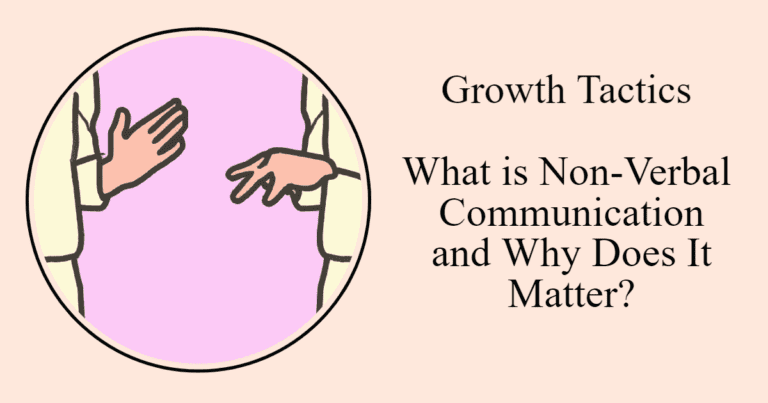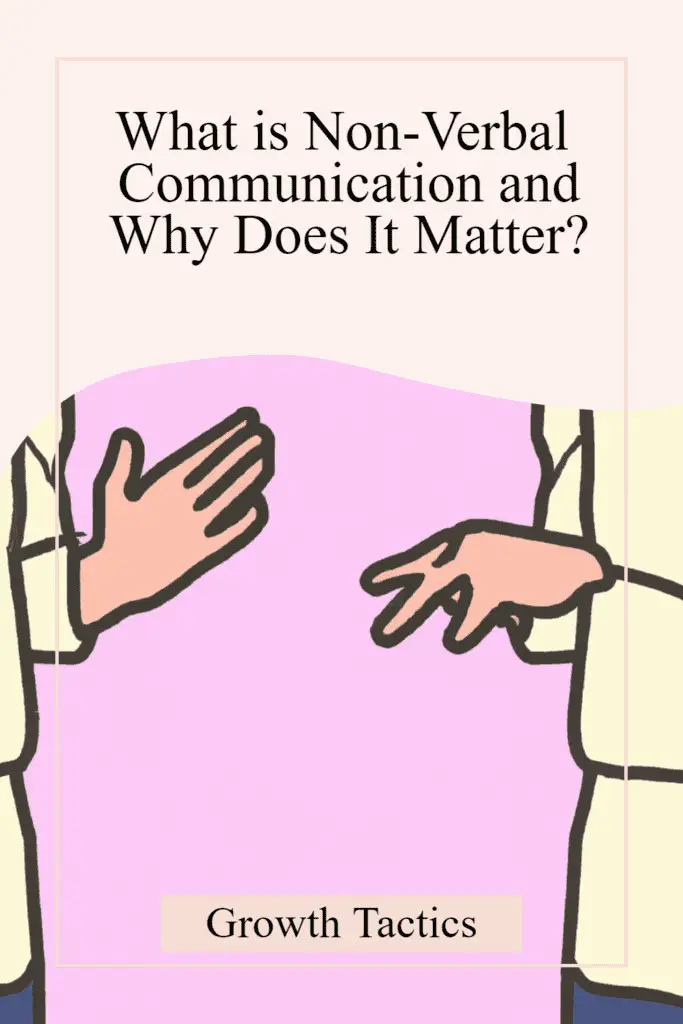When you’re trying to communicate with someone, it’s not just what you say that matters. In fact, non-verbal communication is almost as important as the words themselves. And since we all communicate differently, understanding how your non-verbal communication impacts others can be helpful in conveying the right message at the right time.
So what is non-verbal communication?
Jump To Section
Non-verbal communication is often an unconscious behavior but it’s still super important.

Let’s start by defining non-verbal communication. Non-verbal communication is a form of communication that uses body language, gestures, eye contact, and other forms of behavior to convey a message.
It’s important to note that non-verbal communication often occurs outside of our conscious awareness – this means that we may be able to pick up on more than we realize when it comes to reading people’s non-verbal cues.
In fact, research shows that 93% of all human interactions are based on body language alone! Although this sounds like an overwhelming amount at first glance, it actually makes sense when you think about how much information is communicated in those short bursts of time between words when you first meet someone new or shake hands for the first time with someone.
Eye contact and tone of voice are two examples of non-verbal communication.

Eye contact is a powerful non-verbal cue. It can be used to assert yourself, show interest in another person, demonstrate your listening skills, and more.
In fact, eye contact is so important that it’s one of the first things you notice about someone. If someone isn’t making eye contact with you, they seem disinterested and could even be lying to you!
This is because eye contact is often used as an indicator of understanding or interest between two people. When two people are talking closely together and looking at each other directly while speaking but then the person who was speaking ends up looking away from their partner (and thus breaking eye contact) this tends to indicate that something has changed about the nature or direction of their conversation.
This is also true when someone is talking to you, but they break eye contact. This can be a sign that the person isn’t interested in what you’re saying or doesn’t believe it.
You can use your non-verbal communication to assert yourself.
You can use your non-verbal communication to assert yourself.
- Eye contact: It’s important to make eye contact with others while you speak. It shows that you are engaged in the conversation and what is being said. Avoiding eye contact could make others feel as though they’re not being listened to or acknowledged, especially if they’re speaking about something important.
- Tone of voice: Keep your tone level and neutral when communicating, even when you’re upset or frustrated by something that has happened. A calm tone helps keep the situation from escalating further and also conveys respect for those around you—or at least makes them think that you respect them!
- Posture: Good posture reflects confidence, which is essential for any healthy relationship or work environment. It also portrays a sense of self-respect on behalf of the person who holds it well! Poor posture, on the other hand…well…you get what we mean here!
- Use your hands: A lot of the way we communicate is through our hands. They help us express what we’re feeling, whether it’s anger or love, and they can also be a great asset when we need to emphasize something that we’re saying.
Your body language can have a huge impact on how you communicate and how people respond to you.

Non-verbal communication is a form of communication that you use without words. Your body language, tone, voice, and other things all send different messages to the person you’re talking with.
From where you sit in a room to how you hold your hands and arms, your body language can have a huge impact on how you communicate and how people respond to you.
Simple adjustments in your body language can lead to big changes in people’s responses to you. The next time you’re in a conversation, try to pay attention to the way you hold your body and how it affects others.
Notice if you feel more relaxed when your arms are folded or if someone else’s crossed arms make you feel defensive. Try sitting in different positions while talking with someone and see what happens. Your posture can have a significant effect on how people perceive your message and intent.
Non-verbal communication is definitely worth working on.
If you want to improve your non-verbal communication, it is important to be aware of how much your non-verbal communication is influencing your interactions with others.
You must be able to control the way that you communicate so that you can accurately convey what you mean.
You can do a lot of different things to learn more about non-verbal communication. Look up the topic online, read books on it, and even take a class on the subject. Once you have taken these steps to educate yourself about non-verbal communication, it is important that you put what you have learned into practice.
Try to pay attention to how others are communicating with you and see if there are any parts of their message that need improvement. If so, try hard to improve those areas in your own body language so that people will understand what it is that you want them to know.
How to Improve Your Body Language
Effective body language can set you apart as a confident leader, able to connect with others on a profound level. Here are some pragmatic steps to improve your body language, drawing from both military precision and leadership insights.
1. Stand Tall
Your posture speaks volumes. Keep your back straight and shoulders relaxed. This stance projects confidence and readiness. It’s not about appearing rigid, but about showing you are present and in command. Your body is your battlefield; own it.
2. Make Eye Contact
Eye contact creates a powerful connection. When you speak, look people in the eye to show respect and attention. However, be mindful not to stare, as that can feel confrontational. Balance is key; steady, sincere eye contact can establish trust.
3. Use Open Gestures
Avoid crossing your arms or hiding your hands in your pockets. Open gestures, such as using your hands to emphasize points, signal that you are approachable and engaged. Think of these gestures as opening lines of communication, inviting others to connect with your message.
4. Smile Genuinely
A genuine smile can diffuse tension and create a welcoming atmosphere. It’s a simple yet powerful tool to show empathy and warmth. Authenticity in your expression can build bridges that words alone cannot.
5. Mirror Others
Mirroring body language can foster rapport. Subtly mimic the other person’s posture and gestures. This technique, often used in leadership, shows alignment and understanding without saying a word. But remember, subtlety is essential. Overdoing it can come off as insincere.
6. Control Your Hands
Your hands reflect what’s on your mind. Avoid fidgeting or nervous movements. Use deliberate and purposeful hand gestures to reinforce your points. Think of your hands as tools in your communication arsenal, use them wisely.
7. Practice Active Listening
Active listening isn’t just about what you hear; it’s about how you show that you’re engaged. Nod occasionally, keep an open posture, and give appropriate facial responses. This body language signals that you value others’ input, emphasizing the leader within.
8. Use Space Wisely
Respect personal space to make others comfortable. Being mindful of cultural differences in space preferences is crucial. Use your physical placement in a room to command attention when necessary but ensure you respect others’ boundaries.
Is nonverbal communication universal?
When we explore the realm of nonverbal communication, it’s critical to understand that while some signals are universally recognized, many are deeply rooted in cultural contexts. This awareness is crucial for effective leadership and fostering genuine connections across diverse environments.
While it is true that people from different cultures may have different interpretations of these signals, many aspects of nonverbal communication are universal. Facial expressions such as smiling or frowning are understood around the world, as are certain gestures like nodding your head to indicate agreement or shaking your head to indicate disagreement.
However, it’s essential to recognize that not all nonverbal cues translate seamlessly across cultures. For instance, the concept of personal space varies significantly. In many Western cultures, maintaining a certain physical distance during conversation is customary and shows respect. However, in Middle Eastern or Latin cultures, closer proximity is often a sign of engagement and trust.
Another key difference lies in eye contact. In the United States and many European countries, direct eye contact is seen as a sign of confidence and honesty. Yet in some Asian cultures, prolonged eye contact can be perceived as confrontational or disrespectful. Understanding these nuances can be the difference between building rapport and inadvertently causing discomfort.
Gestures also carry different meanings across borders. The thumbs-up sign, commonly a positive gesture in many parts of the world, may be considered offensive in places such as the Middle East. Similarly, while the ‘OK’ hand gesture signifies approval in many Western countries, it is highly inappropriate in some cultures, like Brazil.
All interactions have some element of non-verbal communication.
Non-verbal communication is a big part of all interactions. Body language can tell others how you feel about them and what you think about the situation. It can also help to send messages that are not said out loud. For example, if someone is trying to convey something important, they may do so by using hand gestures or facial expressions.
Conclusion
Non-verbal communication is a great way to help you get your point across, but it’s not the only way. You can also use verbal communication to make sure that people understand what you mean, or even read body language (like how someone shakes their head) as a way of telling them no. Even if they don’t consciously register this information, they may still pick up on some signals without realizing it!
Did you find this article on non-verbal communication useful? Please share and subscribe below.


